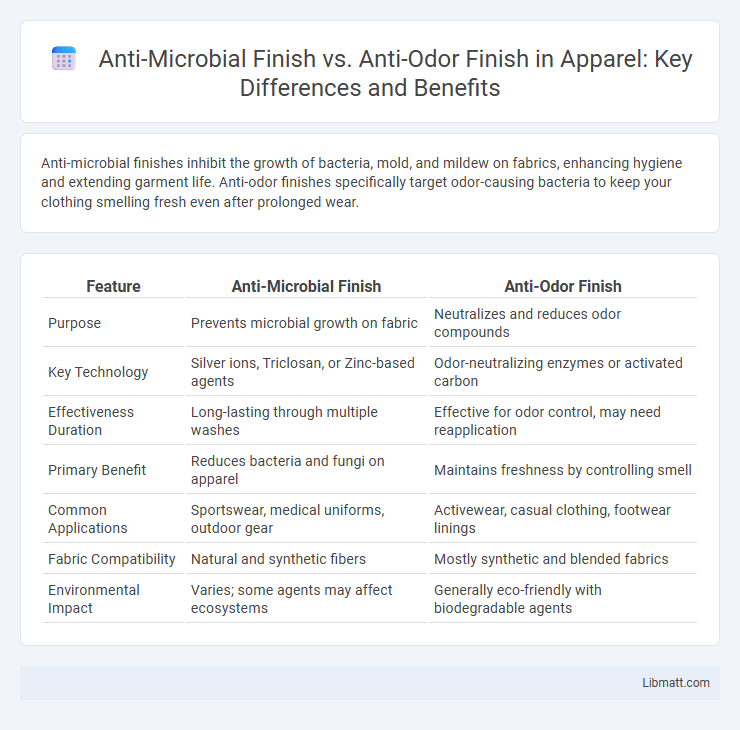Anti-microbial finishes inhibit the growth of bacteria, mold, and mildew on fabrics, enhancing hygiene and extending garment life. Anti-odor finishes specifically target odor-causing bacteria to keep your clothing smelling fresh even after prolonged wear.
Table of Comparison
| Feature | Anti-Microbial Finish | Anti-Odor Finish |
|---|---|---|
| Purpose | Prevents microbial growth on fabric | Neutralizes and reduces odor compounds |
| Key Technology | Silver ions, Triclosan, or Zinc-based agents | Odor-neutralizing enzymes or activated carbon |
| Effectiveness Duration | Long-lasting through multiple washes | Effective for odor control, may need reapplication |
| Primary Benefit | Reduces bacteria and fungi on apparel | Maintains freshness by controlling smell |
| Common Applications | Sportswear, medical uniforms, outdoor gear | Activewear, casual clothing, footwear linings |
| Fabric Compatibility | Natural and synthetic fibers | Mostly synthetic and blended fabrics |
| Environmental Impact | Varies; some agents may affect ecosystems | Generally eco-friendly with biodegradable agents |
Understanding Anti-Microbial vs Anti-Odor Finishes
Anti-Microbial finishes inhibit the growth of bacteria, mold, and mildew on fabric surfaces, effectively reducing contamination and enhancing hygiene by destroying microorganisms. Anti-Odor finishes target odor-causing compounds by neutralizing or blocking them, keeping fabrics smelling fresh without necessarily killing microbes. Understanding the differences helps you choose the right treatment for your textiles based on whether hygiene or odor control is your primary concern.
How Anti-Microbial Finishes Work
Anti-microbial finishes work by incorporating agents such as silver ions, copper, or zinc-based compounds that disrupt the cellular functions of bacteria, fungi, and other microorganisms on fabric surfaces. These agents interfere with microbial reproduction and metabolism, effectively reducing the growth and spread of odor-causing and potentially harmful microbes. Unlike anti-odor finishes, which primarily mask or neutralize smells, anti-microbial treatments provide a longer-lasting barrier by actively inhibiting microbial colonization on textiles.
The Science Behind Anti-Odor Finishes
Anti-odor finishes utilize antimicrobial agents that inhibit the growth of odor-causing bacteria on textiles by disrupting bacterial cell membranes or metabolic processes. These finishes often incorporate silver ions, zinc pyrithione, or quaternary ammonium compounds, which provide long-lasting protection by preventing bacterial colonization and biofilm formation. Unlike traditional anti-microbial finishes that broadly target microbes, anti-odor technologies specifically aim to neutralize or eliminate compounds responsible for unpleasant smells, maintaining fabric freshness during extended wear.
Key Differences Between Anti-Microbial and Anti-Odor Technologies
Anti-microbial finishes inhibit the growth of bacteria, fungi, and other microbes on fabric surfaces, preventing stains, odors, and deterioration. Anti-odor finishes specifically target the neutralization or reduction of odor-causing molecules, often by breaking down sweat and bacteria byproducts. Understanding these key differences helps you choose the right textile treatment for enhanced hygiene or odor control based on your specific needs.
Common Applications for Anti-Microbial Finishes
Anti-microbial finishes are commonly applied in healthcare textiles, sportswear, bedding, and upholstery to inhibit the growth of bacteria, fungi, and other microorganisms, thereby enhancing hygiene and fabric longevity. These finishes are essential in medical environments for preventing hospital-acquired infections and in activewear to reduce odor-causing bacteria. Unlike anti-odor finishes, which primarily target odor neutralization, anti-microbial finishes provide a broader protective barrier against potential microbial contamination.
Typical Uses for Anti-Odor Finishes
Anti-odor finishes are commonly applied in athletic wear, socks, and casual clothing to inhibit the growth of odor-causing bacteria and maintain freshness during extended use. These finishes utilize agents like silver ions or zinc compounds that neutralize odors without affecting fabric breathability. Unlike anti-microbial finishes primarily designed to prevent microbial growth for hygiene, anti-odor finishes specifically target odor control in textiles exposed to sweat and body heat.
Effectiveness and Limitations of Each Finish
Anti-microbial finishes effectively inhibit the growth of bacteria and fungi on textile surfaces, reducing the risk of odor and fabric degradation, but their longevity can be limited by washing and wear. Anti-odor finishes specifically target odor-causing compounds by neutralizing or trapping them, providing temporary freshness but often requiring reapplication after multiple uses. Both finishes improve hygiene and comfort but vary in durability and scope of protection, with anti-microbial finishes offering broader microbial control and anti-odor finishes focusing on scent management.
Health and Safety Implications
Anti-microbial finishes inhibit the growth of bacteria, mold, and fungi on surfaces, reducing the risk of infections and cross-contamination in healthcare and everyday environments. Anti-odor finishes neutralize odor-causing bacteria, improving comfort and hygiene without necessarily killing bacteria, which may limit their effectiveness in preventing disease transmission. Both finishes contribute to health and safety by enhancing cleanliness, but anti-microbial treatments offer broader protection against harmful microorganisms.
Environmental Impact Comparison
Anti-microbial finishes inhibit the growth of bacteria and fungi on textiles, often relying on chemical agents such as silver or triclosan, which can persist in the environment and contribute to ecological toxicity. Anti-odor finishes typically neutralize odors by targeting odor-causing compounds without necessarily killing microbes, and often use enzymatic or natural-based substances with a lower environmental footprint. Your choice between these finishes should consider potential bioaccumulation and biodegradability, favoring anti-odor solutions when minimizing environmental impact is a priority.
Choosing the Right Finish for Your Needs
Choosing the right finish depends on your specific needs: an Anti-Microbial Finish inhibits the growth of bacteria and fungi, making it ideal for environments requiring enhanced hygiene, such as healthcare and sportswear. In contrast, an Anti-Odor Finish targets odor-causing bacteria, providing long-lasting freshness for everyday clothing and activewear. Evaluate the primary concern--microbial contamination or odor control--to select the most effective treatment for your textiles.
Anti-Microbial Finish vs Anti-Odor Finish Infographic

 libmatt.com
libmatt.com